
Table of Contents
Scientific Classification
- Kingdom: Animalia
- Phylum: Chordata
- Class: Reptilia
- Order: Squamata
- Suborder: Serpentes
- Family: Colubridae
- Genus: Heterodon
Quick Overview
Hognose snakes are notable for their distinct upturned snouts, used effectively for digging and burrowing. Predominantly found in North America, their gentle disposition combined with unique defensive behaviors has earned them popularity in the pet trade.
Fast Facts
- Scientific Name: Heterodon spp.
- Lifespan: Up to 15 years in the wild; potential for a longer lifespan in captivity with appropriate care.
- Average Size: Typically ranging from 1 to 3 feet, depending on the species.
- Diet: Carnivorous, with a marked preference for amphibians.
- Habitat: A mix of grasslands, woodlands, and coastal areas, especially favoring sandy or loose soils.
Did you know?
When threatened, hognose snakes might enact a convincing death-feigning display, rolling onto their backs and gaping their mouths.
Appearance
The hognose snake, characterized by its flattened, upturned snout, offers a remarkable display of keeled scales in various colors and patterns, serving both as camouflage and a warning.
Size and Weight
Hognose snakes can measure between 1 to 3 feet, with females often being slightly larger than their male counterparts. Their weight is variable, depending on factors like age, diet, and specific species.
Temperament and Behavior
While generally docile towards humans, hognose snakes can become defensive if they feel threatened. They might puff up, hiss loudly, and if other deterrents fail, resort to their signature feigning-death act.
Fun Fact
In their elaborate display of feigning death, hognose snakes might also emit a foul-smelling musk as an additional deterrent to predators.
Habitat and Distribution
Endemic to North America, hognose snakes are spread from southern Canada to northern Mexico. They show a preference for areas with sandy or loose soils, facilitating their love for burrowing.
Care Guide
For prospective hognose snake owners:
- Ensure an appropriate enclosure with hiding spots.
- Maintain a temperature gradient: 78-85°F (26-29°C) on the warm side, 75-80°F (24-27°C) on the cool side.
- Keep humidity levels at 30-50%.
- Feed your snake appropriately-sized prey (mice or rat pups) every 5-7 days.
- Remember to schedule regular health check-ups and limit handling.

Diet and Nutrition
Primarily carnivores, hognose snakes have a significant appetite for toads. Their specialized saliva and rear fangs aid in safely consuming and digesting these often toxic amphibians. They’ll also consume small rodents, birds, and other reptiles.
Health and Wellness
In captive environments, hognose snakes require specific attention to diet, habitat temperature, and humidity. Without proper care, they could develop health issues like scale rot or respiratory infections.
Breeding
After mating, female hognose snakes lay their eggs, typically during the warmer summer months. The number of eggs and the incubation period can vary by species and environmental conditions.
Conservation Status
As of 2023, most hognose snake species are classified as “Least Concern.” Despite this, they face threats from habitat destruction, road mortality, and illegal collection for the pet trade. Efforts are ongoing in specific regions to ensure their protection.
Fun Fact
When hunting toads, hognose snakes might “pin” them down, prompting the toad to inflate. The snake then uses its rear fangs to safely deflate and consume the toad.
Photo Gallery
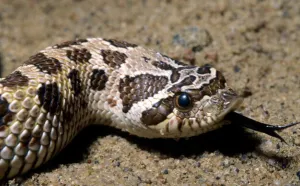
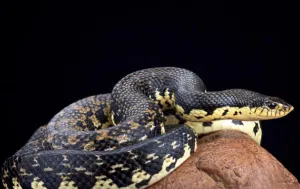
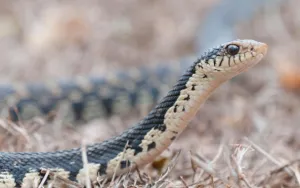
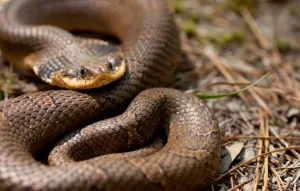
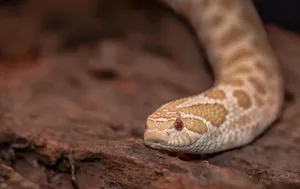

Check out the video below of the Hognose snake performing its death-feigning act:
Related Profiles
Share This Profile:
3 Amazing Facts About Hognose Snake
- Theatrical Defense: When threatened, hognose snakes pull out all the stops—they might regurgitate their meal, bleed from their mouths, release a foul odor, and even convincingly act dead.
- Toad Connoisseurs: Their diet leans heavily towards toads. Over time, hognose snakes have evolved specific adaptations, including toxin resistance and the ability to safely handle inflated toads with their rear fangs.
- Versatile Habitat Preference: From grasslands to woodlands, hognose snakes demonstrate adaptability, indicating their resilience and versatility in different environments.
- Enchi Ball Python: A Unique and Stunning Morph of Python regius - March 27, 2025
- Emerald Tree Monitor: The Enigmatic Green Guardian of the Rainforest - March 26, 2025
- The Egyptian Cobra (Naja haje): A Fascinating Serpent - March 25, 2025
